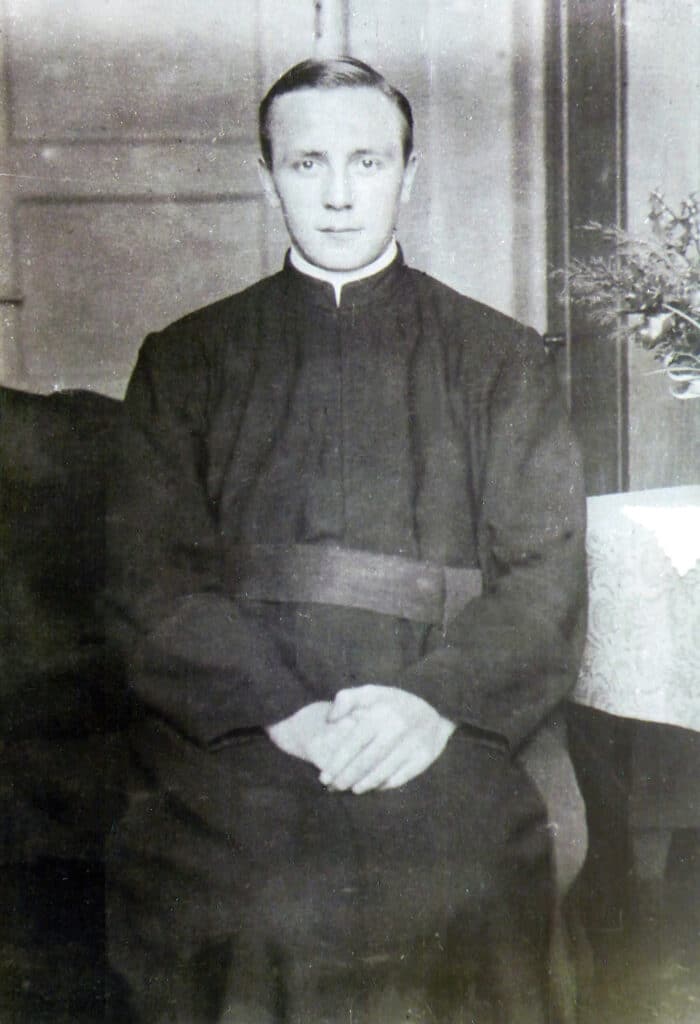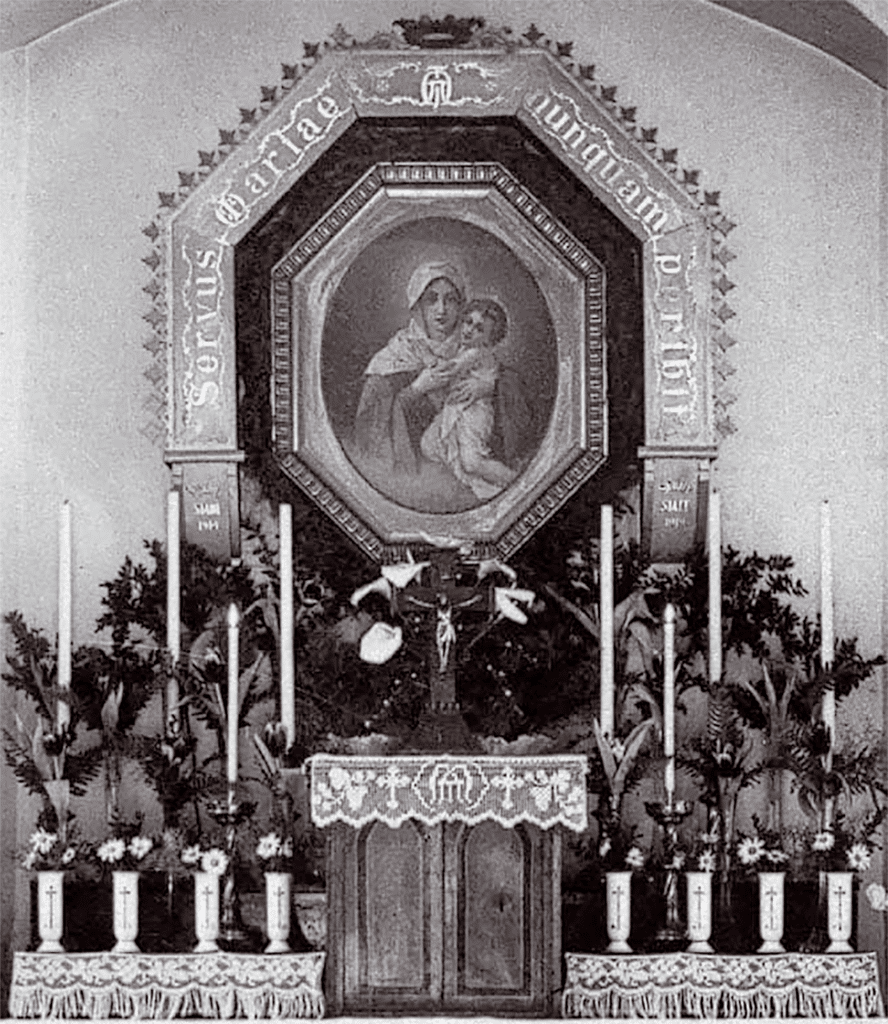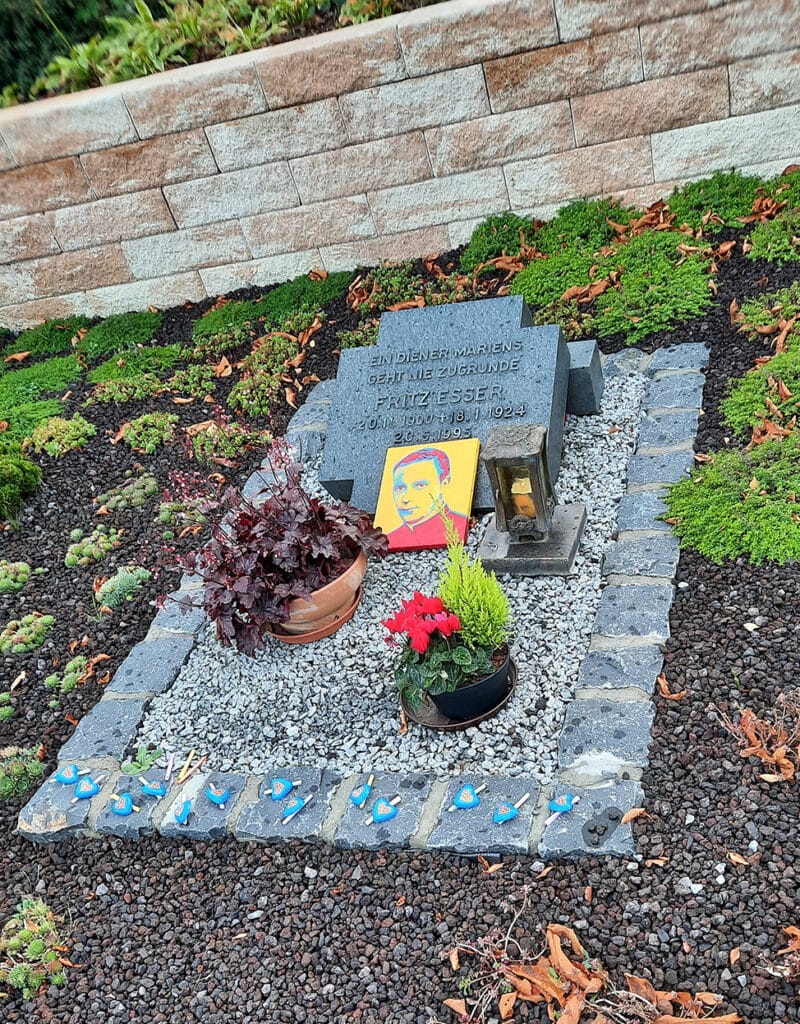When you were a student, do you remember ever cheating on an exam? Certainly not noble behavior, but it is often a desperate decision that leads many to pass. This is how young Fritz Esser “did what he could” to pass his exams. With this in mind, we begin to discuss the story of this young hero who died on January 18, 1924, exactly 100 years ago. Esser demonstrates that life’s mistakes and challenges are opportunities for heroism and a fresh start. The Covenant of Love that guided his life is a light on the path to holiness for us today as well.
Who is Fritz Esser?
He is one of the heroes of the first generation of the Schoenstatt Movement. He was the sacristan of the Original Shrine and became known for creating the luminous frame with the phrase “Servus Mariae Nunquam Peribit”.
Esser was born on November 20, 1900, in Dorn Dürkheim, Rheinhessen. He had two sisters and an older brother who became a priest. His father died before Fritz was one year old and his mother probably ran a small store to support the family.
By nature, he was a cheerful, engaging, and friendly young man, loved by all. With his sanguine temperament, he quickly earned the favor, affection and appreciation of his classmates and teachers.

“I’m ten times dumber than I look”
Fritz had many social and personal skills. However, his biggest challenge was studying. He studied hard, but every test was always a big problem. He was able to pass his exams only with a lot of help from his classmates, especially his friend Joseph Engling, and the generosity of his teachers. His friends held him in such high esteem that they did everything they could to keep him there. One of them tried to get Fritz to “cheat” on the final exam of his first year. Fortunately, the seminary evaluations also took into account a student’s dedication to study, genuine character, effort and commitment… and in this he was highly rated!
This difficulty with his studies was precisely what brought Esser closer and closer to Our Lady. It can be said that, in the early years, the person who was most dedicated to the Original Shrine and took care of it in a singular way, making it welcoming and attractive, was Fritz Esser.
A discreet but significant hero
Fritz did not stand out for his brilliant ideas, his intelligence, or his great achievements, but for the ease with which he was enthusiastic about everything that was good. He was committed to making contributions to the Capital of Grace and to the idea of transforming the small chapel into an MTA Shrine.
In a unique way, and more than anyone else, he made of the Shrine his main occupation. There, so to speak, he “lost his heart”. For years, he devoted almost all of his free time to using his artistic skills to make the Shrine a beautiful, attractive and welcoming place. He not only visited the Shrine to pray, but also to keep it clean, decorate it with flowers, and make it a spiritual home for the sodalists.
Realizing that visits to the small chapel were dwindling, Fritz had an interesting idea. Together with some colleagues, he drilled holes in the chapel’s roof and installed a small tin chimney. He found (it is not known where) a coal stove and used it to dry and heat the Shrine. And so, not infrequently, the Shrine was the only warm place, while everywhere else there was snow, ice and cold. Evidently, the number of visitors greatly increased!
A servant of Mary will never perish!
For all that the MTA had achieved in his life and in the lives of the sodalists, Esser decided to create a memorial. Thus, the idea of the luminous frame “Servus Mariae Nunquam Peribit” was born. His wish was that, in contemplating this monument, everyone would feel a bold and victorious confidence in the power and love of the Blessed Mother.

Between downfalls and new beginnings
Fritz’s life was also marked by trials and failures. Although he spent a short time in the army, this environment had a great impact on his religious and noble life. When he returned, he was changed: unmotivated and far removed from his ideals. He even refused to take care of the Shrine. At times he was also discouraged by the activities of the Congregation and unwilling to help.
However, realizing his mistakes and seeking reparation, he gradually opened his heart to the MTA to re-educate him. Realizing that he needed help, Fritz sought the guidance of his spiritual director, Father Joseph Kentenich, and the advice of his friend Joseph Engling.
Years of surrender and suffering
Three years of illness and suffering marked the end of Fritz Esser’s life. There were weeks in which he could not get out of bed, due to the weakness of his lungs. At the same time, it was a period of great apostolic activity, writing letters and material for the MTA magazine. His bed became a kind of secretariat to support Schoenstatt’s activities.
The end of his life was characterized by suffering lived with love and purpose. He dedicated his pain and all his energies to the beginnings of the Schoenstatt Movement. In his last letter to Father Kentenich, Fritz wrote: “Tell them that I remain faithful until death!”.
Practical advice for life
After his death, Fritz Esser was moved from his first burial place, Alzey in Rhine-Hesse, to the Schoenstatt Center in Weiskirchen in 1995. His grave now lies next to that of Monsignor Werner Krimm (1928-2000), a priest of the Diocese of Mainz and a member of the Schoenstatt Institute, who saw to it that the memory of Fritz Esser remained alive, especially on the diocesan level.

In these 100 years that have passed, we remember Fritz Esser’s life with great appreciation. His story has left imprints that inspire us. Werner Krimm also left for us an impression of Fritz Esser’s life: first of all, his vivid attachment to the Original Shrine in Schoenstatt, where he was one of those responsible for its development, especially as a sacristan. He contributed to the fact that the members of Schoenstatt’s founding generation enjoyed visiting this place. Fritz Esser was also an example of how a person from Rhenania with quite a cheerful character could strive to lead a meaningful spiritual life. He did so under the guidance of his constant spiritual advisor, Father Kentenich who gave Fritz the following words of encouragement during his serious illness toward the end of his life: “Remain the carefree child of our heavenly Mother!”

